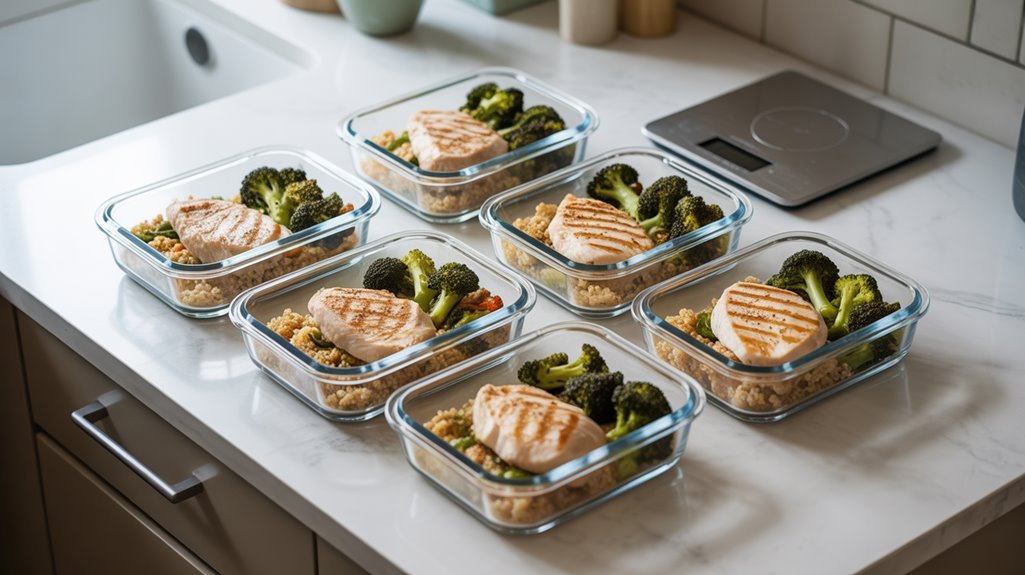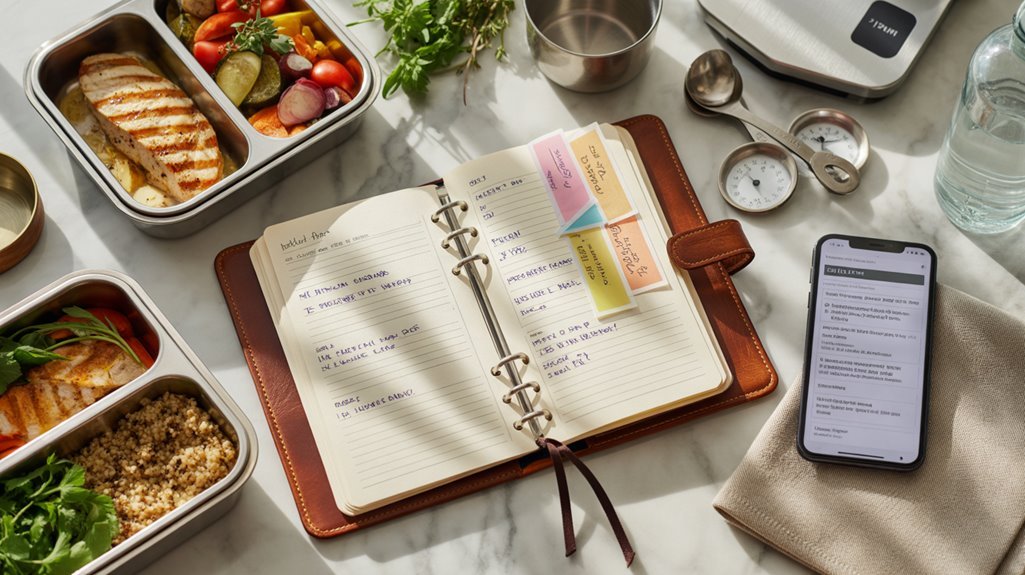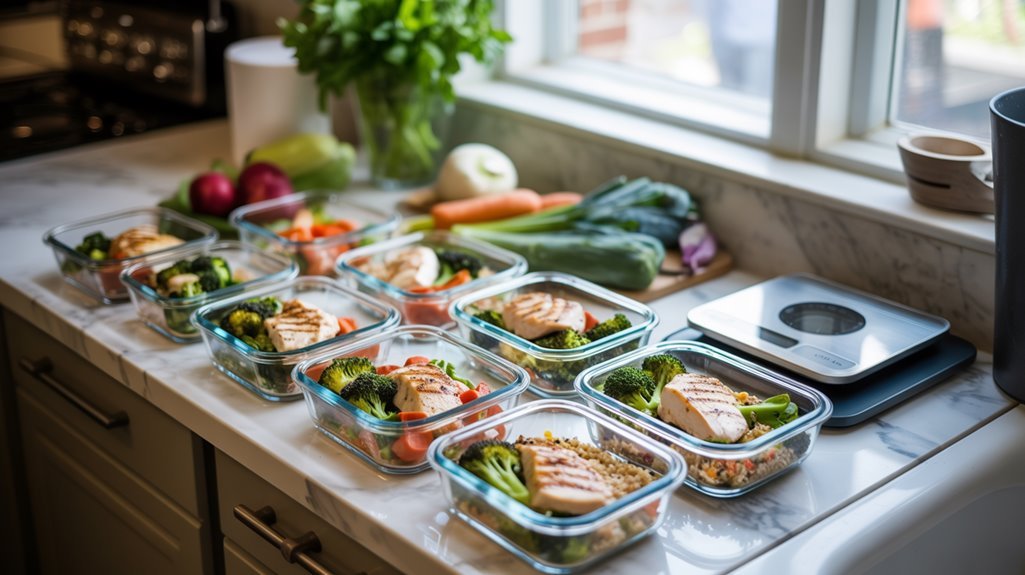You’ll achieve sustainable fat loss by calculating your TDEE and creating a 300-500 calorie deficit with adequate protein (0.8-1g per pound). Batch prep proteins and vegetables on weekends, storing them in clear containers for easy access. Use hand-based portions—palm for protein, fist for vegetables—and create flexible template meals you can rotate. Track weekly measurements, not daily weight fluctuations, and adjust calories by 100-150 if progress stalls for two weeks. Master these systematic approaches to transform your results.
Key Takeaways
- Create a sustainable calorie deficit of 300-500 calories below your TDEE while maintaining adequate protein intake.
- Batch prep proteins and vegetables on weekends, storing in clear containers for easy weekday meal assembly.
- Use flexible template meals combining protein, non-starchy vegetables, and complex carbs for variety without decision fatigue.
- Control portions using hand measurements: palm for protein, fist for vegetables, cupped hand for carbs, thumb for fats.
- Track weekly measurements and energy levels rather than daily weight fluctuations to make evidence-based adjustments.
Calculate Your Daily Calorie and Macro Targets
How can you create an effective fat loss meal plan without knowing your nutritional targets? You can’t. That’s why calculating your daily calorie and macronutrient requirements forms the foundation of successful fat loss.
Start by using evidence-based calorie calculators that factor in your age, sex, height, weight, and activity level. These tools estimate your Total Daily Energy Expenditure (TDEE), then subtract 300-500 calories to create a sustainable deficit.
Next, determine your macro ratios. Research supports moderate protein intake (0.8-1g per pound of body weight) to preserve muscle mass during caloric restriction. Allocate 20-30% of calories to fats for hormone production and satiety. Fill remaining calories with carbohydrates, adjusting based on training intensity and personal preference. Track these targets consistently for best results.
Build a Master Grocery List for Quick Shopping
Creating a master grocery list streamlines your shopping trips and guarantees you’ll always have fat-loss-friendly foods on hand. You’ll need to stock three key categories: lean proteins that support muscle maintenance during caloric deficit, complex carbohydrates that provide sustained energy, and healthy fats that optimize hormone production and satiety. Research shows that people who shop with organized lists make 23% fewer impulse purchases and stick to their nutrition plans more consistently.
Essential Protein Sources
When you’re pursuing fat loss through meal planning, protein becomes your metabolic ally—research shows it preserves lean muscle mass during caloric deficits while requiring up to 30% of its calories just for digestion and absorption. You’ll maximize results by diversifying your protein sources: incorporate lean meats like chicken breast and turkey, seafood variety including salmon and cod, and budget proteins such as eggs and Greek yogurt.
Don’t overlook plant proteins—lentils, chickpeas, and quinoa provide fiber alongside amino acids. Consider egg alternatives and dairy options based on your tolerance. Strategic protein timing enhances satiety when you consume 20-30g per meal. Stock protein supplements for convenience, source from local sources when possible, and master cooking methods like grilling and baking to minimize added fats while preserving nutrient density.
Healthy Carb Options
While protein drives metabolic efficiency, selecting the right carbohydrates fuels your workouts and stabilizes blood sugar—both critical for sustainable fat loss. You’ll maximize results by choosing nutrient-dense whole grains and starchy vegetables over refined options.
| Carb Source | Portion Size (Cooked) |
|---|---|
| Quinoa | ½ cup (90g) |
| Brown Rice | ⅓ cup (65g) |
| Sweet Potatoes | 1 medium (150g) |
| Oatmeal Varieties | ½ cup (80g) |
| Black Beans | ½ cup (85g) |
Prioritize fiber sources like legumes options and fruit choices that slow digestion and enhance satiety. Quinoa benefits include complete protein and iron, while sweet potatoes provide beta-carotene. Steel-cut oatmeal varieties offer superior texture and lower glycemic impact than instant versions. Time your higher portions around training sessions for peak performance and recovery.
Smart Fat Choices
In spite of cutting calories for fat loss, you’ll need adequate dietary fat to optimize hormones, absorb vitamins, and control hunger between meals. Focus on healthy fats like avocado, nuts, seeds, and olive oil rather than processed fat substitutes that lack nutritional value.
Prioritize omega sources including fatty fish, walnuts, and flaxseeds to support metabolic function and reduce inflammation. Practice fat portioning by measuring oils (1 tablespoon), nuts (1 ounce), and nut butters (2 tablespoons) to prevent overconsumption.
Strategic fat timing enhances results. Consume fats with breakfast to stabilize blood sugar and include them post-workout to aid nutrient absorption. You’ll maintain satiety longer when combining fats with protein and fiber, preventing energy crashes that trigger cravings.
Batch Prep Proteins and Vegetables on Weekends
Two hours of weekend prep can transform your entire week’s eating habits. You’ll eliminate daily cooking stress while ensuring consistent nutrition for fat loss success.
Start by preparing lean proteins in bulk. Grill chicken breasts, bake salmon fillets, and hard-boil eggs simultaneously. Divide portions into airtight containers for proper protein storage in your refrigerator, maintaining freshness for up to four days.
Bulk protein prep saves time: grill chicken, bake salmon, boil eggs, then portion into containers for four-day freshness.
Next, wash and chop fibrous vegetables like broccoli, bell peppers, and zucchini. Apply different vegetable seasoning blends – herbs, spices, and minimal olive oil – before roasting at 400°F. This creates variety without adding excess calories.
Store prepped items in clear containers at eye level. You’re more likely to consume healthy foods when they’re visible and ready to eat. This systematic approach prevents impulsive food choices throughout busy weekdays.
Create Flexible Template Meals You Can Rotate

You’ll achieve sustainable fat loss by developing template meals with interchangeable components rather than rigid recipes. Start with base templates like “protein + non-starchy vegetable + complex carb” or “protein + leafy greens + healthy fat,” then rotate different foods within each category throughout the week. This mix-and-match approach prevents dietary boredom while ensuring you maintain appropriate macronutrient ratios and caloric intake for your fat loss goals.
Build Base Recipe Templates
When you’re serious about fat loss, building a collection of base recipe templates becomes your strategic advantage for consistent meal planning. You’ll create foundational recipes that serve as starting points for multiple meals, eliminating decision fatigue while maintaining nutritional targets.
Start with versatile protein-vegetable combinations that support your caloric deficit. For example, establish a basic stir-fry template using lean protein, non-starchy vegetables, and measured cooking oil. This foundation allows endless template variations through different spice blends, vegetable combinations, and protein sources.
Recipe customization guarantees you won’t experience flavor fatigue. Transform your base chicken and broccoli template into Mediterranean, Asian, or Mexican-inspired dishes by adjusting seasonings and accompaniments. Document successful combinations, noting macronutrient breakdowns for efficient tracking. This systematic approach streamlines preparation while supporting sustainable fat loss.
Mix Match Components
| Component | Options | Combinations |
|---|---|---|
| Proteins | Chicken, tofu, fish | 3 choices |
| Carbs | Rice, quinoa, potatoes | 3 choices |
| Vegetables | Broccoli, spinach, peppers | 3 choices |
Mix-and-match methodology yields 27 unique meal combinations from just nine base ingredients. You’re fundamentally batch-cooking individual components rather than complete meals, maximizing freshness and minimizing preparation time while adhering to your caloric requirements.
Use Strategic Portion Control Methods
Strategic portion control remains one of the most effective yet underutilized tools for sustainable fat loss. You’ll achieve better results by employing evidence-based methods that naturally regulate calorie intake without constant measuring.
Master these proven portion control strategies:
- Hand-based measurements: Use your palm for protein, fist for vegetables, cupped hand for carbs, and thumb for fats
- Pre-portioned containers: Divide meals immediately after cooking to prevent overeating
- Smaller plates: Research shows 9-inch plates reduce consumption by 22% compared to 12-inch plates
- Mindful eating practices: Chew slowly, eliminate distractions, and pause between bites
These techniques activate psychological and physiological satiety mechanisms. You’re training your brain to recognize appropriate portions while maintaining nutritional adequacy. Consistent application creates automatic habits that support long-term weight management.
Plan for Social Events and Restaurant Meals

While social gatherings and restaurant dining present common challenges to fat loss goals, you can navigate these situations successfully with proper planning and smart strategies. Research shows that planning ahead greatly improves adherence to nutritional goals during social events.
Before dining out, review online menus to identify healthier meal choices and practice menu navigation skills. You’ll make better decisions when you’re not influenced by hunger or peer pressure. Request food swaps like salads instead of fries, and control portion sizes by boxing half your entrée immediately.
Implement social strategies by eating a protein-rich snack beforehand and focusing on mindful eating during the event. Consider suggesting restaurant alternatives that offer healthier options. Practice saying “no thank you” to food pushers while maintaining social connections.
Track Progress and Adjust Your Plan Weekly
After applying your meal plan, you’ll need consistent monitoring to verify it’s working effectively for your fat loss goals. Weekly check-ins provide critical data for making evidence-based progress adjustments to optimize results.
Track these key metrics systematically:
- Body measurements – Waist, hips, and chest circumference reveal fat distribution changes
- Scale weight – Monitor trends rather than daily fluctuations for accurate assessment
- Energy levels – Document daily vitality to confirm adequate caloric intake
- Hunger patterns – Record appetite changes to fine-tune meal timing and portions
When progress stalls for two consecutive weeks, execute strategic modifications. Reduce daily calories by 100-150 or increase activity levels. Conversely, if you’re losing weight too rapidly (>2 pounds weekly), add 100-200 calories to preserve muscle mass and metabolic rate.
Frequently Asked Questions
How Long Does It Take to See Fat Loss Results From Meal Planning?
You’ll typically notice fat loss results within 2-4 weeks when following consistent meal planning frequency. Your fat loss timeline depends on individual factors like metabolism, caloric deficit, and adherence to your structured eating plan.
Can I Meal Plan Effectively if I Have Food Allergies or Intolerances?
You can absolutely meal plan with allergies or intolerances. Research shows allergy friendly recipes work well when you identify safe meal prep substitutions. You’ll need to carefully read labels and focus on whole, unprocessed foods.
What Kitchen Tools and Containers Are Essential for Meal Planning Success?
You’ll need quality meal prep containers with secure lids for portion control and storage. Essential kitchen gadgets include a food scale, sharp knives, cutting boards, and measuring cups. These tools streamline batch cooking and guarantee consistent portions.
How Do I Handle Meal Planning When Family Members Have Different Dietary Goals?
You’ll need flexible recipes that accommodate various dietary needs. Research shows family meal strategies like customizable base dishes work best. Prepare proteins, grains, and vegetables separately, letting everyone adjust portions and combinations to match their individual goals.
Should I Eat Different Meals on Workout Versus Rest Days?
You’ll benefit from adjusting your workout nutrition versus rest day meals. Research shows eating more carbohydrates on training days supports performance and recovery, while slightly reducing calories on rest days can enhance fat loss.
Conclusion
You’ve now got the essential tools to create an effective meal planning system for fat loss. By calculating your targets, prepping strategically, and tracking your progress, you’ll maintain the calorie deficit needed for consistent results. Remember, successful fat loss isn’t about perfection—it’s about adherence. Start with these evidence-based strategies, adjust based on your weekly data, and you’ll develop sustainable habits that support long-term weight management while preserving lean muscle mass.




